

Scientists Have 3D Printed Working Human Corneas. 3D printing isn’t just for fashioning new toucan beaks or making tools on Mars – it could someday save you from blindness.
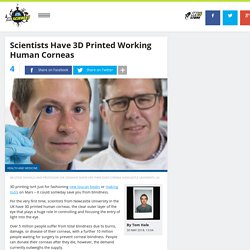
For the very first time, scientists from Newcastle University in the UK have 3D printed human corneas, the clear outer layer of the eye that plays a huge role in controlling and focusing the entry of light into the eye. Over 5 million people suffer from total blindness due to burns, damage, or disease of their corneas, with a further 10 million people waiting for surgery to prevent corneal blindness. People can donate their corneas after they die, however, the demand currently outweighs the supply.
Working, Beating Hearts Will Soon Be 3D-Printed From Patients’ Own Cel. Inside a lab that will open in a couple of months in Chicago, a biotech startup will soon begin perfecting the process of 3D-printing human hearts that could eventually be used in transplants.

“What this is set up to do is to make a patient-specific, fully functioning heart that’s viable for transplant, using the patient’s own cells,” says Stephen Morris, founding partner and CEO of the startup, Biolife4D. The process combines several steps that have been developed by various researchers in university labs. First, a patient’s heart will be scanned using an MRI machine to create a digital image of the heart’s shape and size. Next, doctors will take a blood sample. How 3D printing has changed dentistry, a billion dollar opportunity - 3D Printing Industry. Align Technology Inc., the company behind the Invisalign range of clear-aligner orthodontics, are on track for $1.5 billion in sales this year, according to a new article published by Forbes.

Align has already earned $660 million in the first two quarters of the year, the majority of which comes from clear aligners, and rest from their iTero 3D Scanning system. Align has made a significant impact by combining 3D printing with dentistry. The customised orthodontics are produced within Align’s vast factory of 3D printers, estimated by Forbes to number between 50 and 60. The machines produce 8 million orthodontics per year, a number which has grown steadily following the improvement of Invisalign technology, and the aesthetic and convenience advantages they offer over conventional braces.
The Invisalign process. New Tech Helps Amputees Feel. A new bioelectronic feedback system is giving amputees a muscle sense that will allow them to discern the size of an object without visual proof.
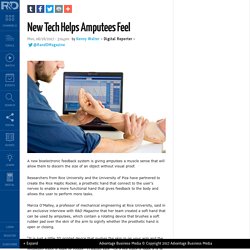
Researchers from Rice University and the University of Piza have partnered to create the Rice Haptic Rocker, a prosthetic hand that connect to the user’s nerves to enable a more functional hand that gives feedback to the body and allows the user to perform more tasks. Marcia O’Malley, a professor of mechanical engineering at Rice University, said in an exclusive interview with R&D Magazine that her team created a soft hand that can be used by amputees, which contain a rotating device that brushes a soft rubber pad over the skin of the arm to signify whether the prosthetic hand is open or closing. “It is just a little 3D printed device that pushes the skin in on your arm and the amount that it pushes your skin is proportionate to the degree that the prosthetic hand is open or closed,” O’Malley said.
This 3D Printer Creates Real Bones Using Synthetic Material. In Brief A new 3D printer created by a University of Waterloo Engineer allows 3D-printed joints and implants that are made of the same minerals as human bone, and they interlock with the patient’s cells to create longer-lasting replacements.

Better substitutes The area of bone regeneration is one that gets a lot of attention nowadays. After the development of plastic and metal implants for bones, scientists have been steadily trying to find ways to improve this technology. One of the most prominent ways is 3D printing. The First 3D Bioprinter That Can Print Body Parts for Large Scale Human Implantation. A Bioprinted Body After 10 years of development, the Wake Forest Institute of Regenerative Medicine has finally unveiled a 3D printer that can craft simple tissues, such as cartilage, into complex shapes suitable for implantation.
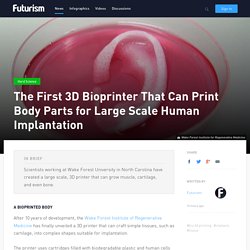
The printer uses cartridges filled with biodegradable plastic and human cells bound in gel form, and it can grow muscle, cartilage, and even bone. When implanted into animals, these crafted tissues have been shown to survive and even thrive for an indefinite amount of time. “This is the first [bioprinter] that can print tissue at the large scales relevant for human implantation,” lead scientist behind the project, Anthony Atala, says in the release. “Basically, once we’ve printed a structure, we can keep it alive for several weeks before we implant it. Carbon3D's Incredible Printer 'Grows' 3D Objects.
"In many ways, traditional 3D printing is actually 2D printing over and over again," said DeSimone.
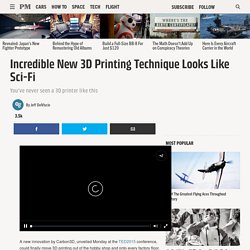
"But we actually grow parts continuously out of liquid resin puddle, and can do it really, really fast, at hundreds to thousands of millimeters an hour. " This Device Lets You Brew Your Own Drugs At Home. Prototype A machine prototype called Farma can let you manufacture your daily prescription of drugs right in your own home.
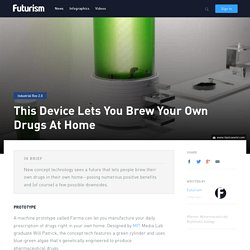
Designed by MIT Media Lab graduate Will Patrick, the concept tech features a green cylinder and uses blue-green algae that’s genetically engineered to produce pharmaceutical drugs. 3-D Printers Give Us a New Way to Think. Ed Smith does some fiendishly difficult surgeries.
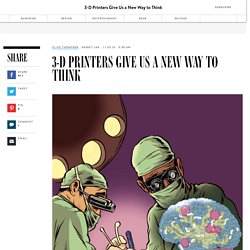
A pediatric neurosurgeon at Boston Children’s Hospital, he often removes tumors and blood vessels that have grown in gnarled, tangled shapes. “It’s really complicated, defusing-a-bomb-type surgery,” he says. So these days, Smith prepares for his work by using an unusual tool: a 3-D printer. Days in advance, hospital techs use standard imaging to print a high-resolution copy of the child’s brain, tumor and all. Smith will examine it for hours, slowly developing a nuanced, tactile feel for the challenge.
Welcome to the complex world of 3D-printed drugs. The prospect of tailor-made drugs that are customised to your individual needs has moved a step closer with the recent announcement of the first 3D-printed (3DP) drug to gain approval from the US food and drug administration (FDA).
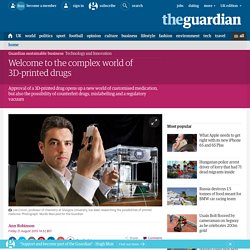
A visit to the pharmacy may soon involve being questioned on your weight, or having your percentage of body fat measured so that the medication can be printed to match your size. Young children, often resistant to taking medication, may be able to choose the colour, shape and design of a tablet that could be designed to dissolve easily.
University graduate wins James Dyson Award for 3D-printed prosthetic hand. Researchers Are 3D Printing Neural Cells Of the Brain, Unlocking New Secrets of the Complex Organ. The 3D printing concept and all that has sprung forth from its technology is a result of some of the most creative and progressive minds of our time. Now, the efforts put forth by those very minds may actually result in giving us a deeper glimpse into the most complex parts of the brain itself, offering scientists a way to look at this most treasured anatomical part of our bodies. Revealing the deepest secrets of this tricky organ, the brain, has often led many to think we would be opening the truest Pandora’s box.
In a first, drug using 3D printing technology gets FDA nod. Until bioprinters are reality, 3D printing can still save lives. A two-year-old girl born with a hole in her heart had a life-saving operation in London last month thanks to a 3D printer. Perhaps equally astounding is that she’s not the first. Mina Khan was born with a hole in the wall between two chambers of her heart, a condition that left her exhausted and unable to gain weight or even grow hair. The deformity was so severe doctors said it likely couldn’t be repaired – but by creating an exact 3D replica of her heart using MRI and computerized tomography scans, surgeons at St. Thomas’ Hospital in London were able to design a bespoke patch, practice and perfect how to stitch it into place, and ultimately perform the surgery successfully on the girl’s actual heart.
Exceeding Expectations. Story Curators: Dawn Dole, Lindsey Godwin, and Matthew Moehle This book is a collection, or anthology, of deep and rich stories about adults, children and communities working together to shape the future of schools and education. Appreciative Inquiry (AI) is the framework explored throughout this book and is a powerful vehicle for multiple generations to consciously collaborate and grow flourishing schools.
The stories in this book share a vast array of examples where AI has been utilized to bring about positive change in educational settings around the globe. We are increasingly seeing the appreciative spirit working its way into our school systems in exciting opportunities. 3D printed heart saves baby’s life as medical technology leaps ahead - News - Gadgets and Tech. Using MRI scan data, Morgan Stanley Children’s Hospital in New York City 3D printed a copy of the child’s heart, which was both riddled with holes and structured unusually. Surgery was going to be complicated and dangerous, but this 3D printed heart provided the surgeons the opportunity to study the organ, and develop a detailed surgery strategy.
“The baby’s heart had holes, which are not uncommon with CHD, but the heart chambers were also in an unusual formation, rather like a maze,” Dr Emile Bacha, who performed the surgery, told Connecticut local media. “In the past we had to stop the heart and look inside to decide what to do. With this technique, it was like we had a road map to guide us. We were able to repair the baby’s heart with one operation.” Doctors Use 3D-Printed Replica Brains To Guide Life-Changing Pediatric Surgery. It seems the applications for 3D printing are endless. Scientists have churned out everything from houses to rocket parts, blood vessels to artificial limbs. Now, to add to the ever-growing collection of awesome 3D-printed goodies, medics have used the famous additive manufacturing technology to produce replicas of infants’ brains in order to practice life-saving but risky surgical procedures.
Having a detailed model of the brain to work with means that surgeons are no longer reliant on MRI scans and instinct to perform highly complex and precise operations. Another Panic Sell Downgrade in Coal - James River Coal Company (NASDAQ:JRCC) 3D Printed Body Parts Go Mainstream. 3D Printed Device Detoxifies Blood Like a Liver. How 3-D Printing Can Help To Cure Cancer. 3D Printed Cast Speeds Bone Recovery Using Ultrasound. A new prototype brings together 3D printing, room to breathe and ultrasound pulses to create a cast that is not only comfortable and stylish to wear but is expected to speed healing relative to existing options. However, despite success in vitro and promising results from clinical studies LIPUS has not been widely adopted, partly because the measured benefit has varied across trials, in some cases appearing too small to justify the effort.
Made-To-Order Cartilage Could Combat Osteoarthritis. How a Harvard Team Just Made It Easier to 3-D Print Organs. Scientists Create 3D Printed Heart Membrane That Can Keep Heart Beating Perfectly Forever. March 9, 2014 AT 1:00 am. New bioprinting technique creates thicker, healthier tissue. The notion of 3D printed biological tissue holds all kinds of possibilities for drug testing and the reparation of damaged cells, though replicating the complexities of human tissue in a lab presents some very big challenges. A new bioprinting method developed by researchers from the Wyss Institute for Biologically Inspired Engineering at Harvard University has enabled the creation of tissue constructs with small blood vessels and multiple cell types, marking important progress toward the printing of living tissue.
Handheld 3D Bio-Pen Could Transform Implants. Kyle Maxey posted on December 10, 2013 | Comment | 3804 views. Photo of the Day: Printing the Human Body. Organs on Demand. RENAL RECONSTRUCTION: Wake Forest postdoctoral fellow Hyun-Wook Kang operates a 3-D printer that is making a kidney prototype with cells and biomaterials.IMAGE COURTESY OF WAKE FOREST INSTITUTE FOR REGENERATIVE MEDICINE.